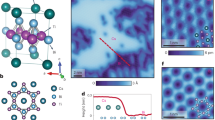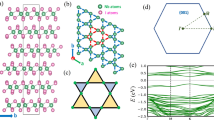Abstract
Two-dimensional (2D) magnetic kagome lattices are constructed using silicon carbide triangular nanoflakes (SiC-TNFs). Two types of structures with alternating Si and C atoms are studied: the first one is constructed using the C-edged SiC-TNFs as the building blocks and C atoms as the linkers of kagome sites (TNF N –C–TNF N ) while the second one is composed of the Si-edged SiC-TNFs with Si atoms as linkers (TNF N –Si–TNF N ). Using density functional theory-based calculations, we show that the fully relaxed TNF N –C–TNF N retains the morphology of regular kagome lattice and is ferromagnetism. On the other hand, the TNF N –Si–TNF N structure is deformed and antiferromagnetic. However, the ground state of TNF N –Si–TNF N structure can be transformed from the antiferromagnetic to ferromagnetic state by applying tensile strain. Monte Carlo simulations indicate that the SiC-TNFs-based kagome lattices can be ferromagnetic at room temperature.





Similar content being viewed by others
References
Akola J, Heiskanen HP, Manninen M (2008) Edge-dependent selection rules in magic triangular graphene flakes. Phys Rev B 77:193410
Alam KM, Ray AK (2007) A hybrid density functional study of zigzag SiC nanotubes. Nanotechnology 18:495706
Alam KM, Ray AK (2008) Hybrid density functional study of armchair SiC nanotubes. Phys Rev B 77:035436
Dai H, Wong EW, Lu YZ, Fan SS, Lieber CM (1995) Synthesis and characterization of carbide nanorods. Nature 375:769–772
Ezawa M (2009) Quasiphase transition and many-spin kondo effects in a graphene nanodisk. Phys Rev B 79:241407(R)
Fernández-Rossier J, Palacios JJ (2007) Magnetism in graphene nanoislands. Phys Rev Lett 99:177204
Gunlyckea D, Li J, Mintmire JW, White CT (2007) Altering low-bias transport in zigzag-edge graphene nanostrips with edge chemistry. Appl Phys Lett 91:112108
Kresse G, Furthmuller J (1996) Efficient iterative schemes for ab initio total-energy calculations using a plane-wave basis set. Phys Rev B 54:11169
Lee H, Son Y-W, Park N, Han S, Yu J (2005) Magnetic ordering at the edges of graphitic fragments: magnetic tail interactions between the edge-localized states. Phys Rev B 72:174431
Li XW, Wang Q, Jena P (2011) Ferromagnetism in two-dimensional carbon chains linked by 1,3,5-benzenetriyl units. J Phys Chem C 115:19621
Mavrandonakis A, Froudakis GE, Schnell M, Mühlhäuser M (2003) From pure carbon to silicon-carbon nanotubes: an ab initio study. Nano Lett 3:1481–1484
Menon M, Richter E, Mavrandonakis A, Froudakis G, Andriotis AN (2004) Structure and stability of SiC nanotubes. Phys Rev B 69:115322
Perdew JP, Burke K, Ernzerhof M (1996) Generalized gradient approximation made simple. Phys Rev Lett 77:3865
Pham-Huu C, Keller N, Ehret G, Ledoux MJ (2001) The first preparation of silicon carbide nanotubes by shape memory synthesis and their catalytic potential. J Catal 200:400–410
Philpott MR, Vukovic S, Kawazoe Y, Lester WA (2010) Edge versus interior in the chemical bonding and magnetism of zigzag edged triangular graphene molecules. J Chem Phys 133:044708
Potasz P, Güçlü AD, Voznyy O, Folk JA, Hawrylak P (2011) Electronic and magnetic properties of triangular graphene quantum rings. Phys Rev B 83:174441
Ramirez AP, Espinosa GP, Cooper AS (1990) Strong frustration and dilution-enhanced order in a quasi-2D spin glass. Phys Rev Lett 64:2070
Rocha AR, Martins TB, Fazzio A, da Silva AJR (2010) Magnetism and perfect spin filtering effect in graphene nanoflakes. Nanotechnology 21:345202
Şahin H, Senger RT, Ciraci S (2010) Spintronic properties of zigzag-edged triangular graphene flakes. J Appl Phys 108:074301
Sato K, Bergqvist L, Kudrnovský J, Dederichs PH, Eriksson O, Turek I, Sanyal B, Bouzerar G, Katayama-Yoshida H, Dinh VA, Fukushima T, Kizaki H, Zeller R (2010) First-principles theory of dilute magnetic semiconductors. Rev Mod Phys 82:1633–1690
Sawada K, Ishii F, Saito M, Okada S, Kawai T (2009) Phase control of graphene nanoribbon by carrier doping: appearance of noncollinear magnetism. Nano Lett 9:269–272
Sawada K, Ishii F, Saito M (2010) Magnetism in graphene nanoribbons on Ni(111): first-principles density functional study. Phys Rev B 82:245426
Schweika W, Valldor M, Lemmens P (2007) Approaching the ground state of the kagomé antiferromagnet. Phys Rev Lett 98:067201
Son Y-W, Cohen ML, Louie SG (2006) Energy gaps in graphene nanoribbons. Phys Rev Lett 97:216803
Sun X-H, Li CP, Wong WK, Wong NB, Lee CS, Lee ST, Teo BK (2002) Formation of silicon carbide nanotubes and nanowires via reaction of Silicon (from disproportionation of silicon monoxide) with carbon nanotubes. J Am Chem Soc 124:14464–14471
Syôzi I (1951) Statistics of kagomé lattice. Prog Theor Phys 6:306
Wang WL, Meng S, Kaxiras E (2008) Graphene nanoflakes with large spin. Nano Lett 8:241–245
Wong EW, Sheenhan PE, Lieber CM (1997) Nanobeam mechanics: elasticity, strength, and toughness of nanorods and nanotubes. Science 277:1971–1975
Yang GY, Wu RB, Chen JJ, Pan Y, Zhai R, Wu LL, Lin J (2007) Growth of SiC nanowires/nanorods using a Fe–Si solution method. Nanotechnology 18:155601
Yazyev OV (2010) Emergence of magnetism in graphene materials and nanostructures. Rep Prog Phys 73:056501
Zhou WM, Liu X, Zhang YF (2006) Simple approach to β-SiC nanowires: synthesis, optical, and electrical properties. Appl Phys Lett 89:223124
Zhou J, Wang Q, Sun Q, Jena P (2011) Intrinsic ferromagnetism in two-dimensional carbon structures: triangular graphene nanoflakes linked by carbon chains. Phys Rev B 84:081402(R)
Acknowledgments
This work is supported by Grants from the National Natural Science Foundation of China (Grant No. NSFC-11174014), the National Grand Fundamental Research 973 Program of China (Grant No. 2012CB921404), and from the US Department of Energy. This research used resources of the National Energy Research Scientific Computing Center, which is supported by the Office of Science of the U.S. Department of Energy under Contract No. DE-AC02-05CH11231. Xiaowei Li would like to acknowledge the support from China Postdoctoral Science Foundation (Grant No. 2012M510246).
Author information
Authors and Affiliations
Corresponding author
Additional information
This article is part of the topical collection on nanomaterials in energy, health and environment
Rights and permissions
About this article
Cite this article
Li, X., Zhou, J., Wang, Q. et al. Magnetic properties of two dimensional silicon carbide triangular nanoflakes-based kagome lattices. J Nanopart Res 14, 1056 (2012). https://doi.org/10.1007/s11051-012-1056-5
Received:
Accepted:
Published:
DOI: https://doi.org/10.1007/s11051-012-1056-5




